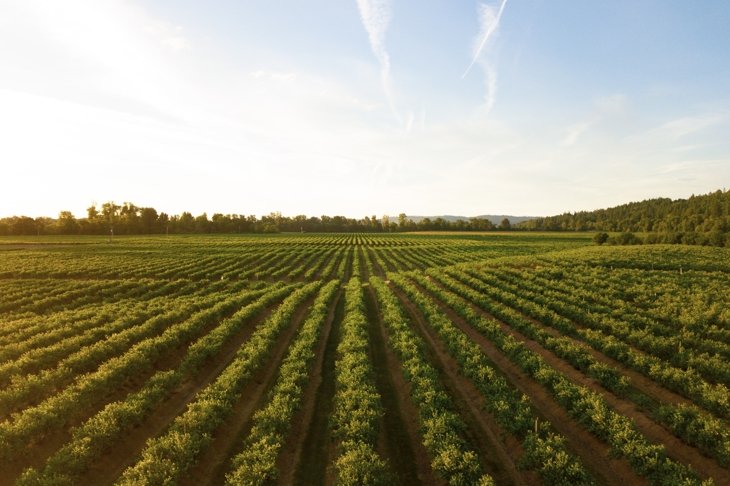
When the COVID-19 crisis hit Canada in early 2020, Arzeena Hamir, owner of Amara Farms, a small organic fruit and vegetable farm in the Comox Valley on Vancouver Island, knew there would be tough times ahead.
With relatives at high risk of suffering serious complications from the virus, her team was not able to attend any indoor farmers’ markets in March and April. Closed restaurants meant that a large chunk of their wholesale market was out of commission.
“Initially, we experienced a loss,” says Hamir. “So, we sat down as a family, and thought—what can we do to recover?”
From coast to coast, farmers, restaurant owners, and food security advocates were asking themselves the same question. Grocery shelves sat empty, while massive amounts of food designated for other locations had to be dumped. Fruit rotted on the vine while farmers waited for much-needed temporary foreign workers, whose poor working and living conditions exposed them to COVID-19, to arrive. However, emerging stories of hope and innovation show us that a better food system—one that is local, resilient, and equitable—is possible, and even necessary.
The need for resilient local food systems
COVID-19 has highlighted the risk of depending on long-distance food supply chains (think apples that come from New Zealand, or beef that comes from Argentina) controlled by a handful of large multinational corporations. This industrial and globalized system is harmful for the planet, farmers, and farm workers alike, and makes us less resilient to shocks like COVID-19.
“Our current system provides food that is extremely cheap, but you get what you pay for,” says Hamir. “People are starting to wonder how we will be fed if it collapses.”
She and other passionate people involved with our food system are using COVID-19 as an opportunity to show us some of the answers.
Small farms, big changes
When confronted with a crisis, Amara’s size was its strength: growing diverse and small-scale crops meant that Hamir’s family could quickly pivot to keep Amara Farms thriving. (Small-scale meat producers faced different challenges due to highly regulated and limited access to abattoirs.)
Her daughter set up an online store for customers to place orders for produce, and they repurposed an old trailer as a contactless pick-up location. They grew potatoes for the first time to make up for gaps in supermarket supply, sold fennel originally grown for restaurants straight to consumers, and tripled their production of seedlings for home gardeners. With the safe reopening of outdoor farmers’ markets, sales are some of the strongest they have ever seen.
“People have realized that if they don’t support local farmers, we won’t be here,” says Hamir.
Did you know?
The BC government is providing free support to local farmers with e-commerce and business planning during the pandemic.
Support your local restaurants
Like most restaurant owners, Andrea Carlson of Burdock & Co, a farm-to-table restaurant in Vancouver, had to temporarily lay off most of her staff at the onset of the pandemic. She and her partner held down the kitchen, cooking classic comfort food as “takeaway” to stay afloat—and they were blown away by the positive response.
Another success was Carlson’s community supported agriculture (CSA) program, which allows consumers to subscribe directly to a farmer’s harvest. During the pandemic, turnover of CSA boxes increased exponentially, from 40 every second week to more than 400 a week out of Burdock & Co’s sister location and 150 from Burdock & Co itself.
“It was the onset of the growing season, and with restaurants closed, farmers were struggling to sell,” she says. “Being able to move hundreds of pounds of their produce was fantastic, even if our margins were slim.”
For many restaurants, the road to recovery will be long and uncertain. If you can’t afford to eat out right now, Carlson says it means a lot to just let them know that you’re there and ready to support them when you can.
“Right now, we’re just trying to stay optimistic,” she says. “It’s daunting to think about what could happen next; but compared to many places in the world, we’re very privileged.”
Ensuring community food security
Richmond Food Security Society (RFSS) executive director Ian Lai dove into the COVID-19 response at full force. Due to school and other service closures, many people in Richmond had lost access to critical meal programs that they depended on.
“Now was the time to make things happen for our community,” he says. “We needed to step up and fill the gaps.”
One of the first responses by RFSS was to support kids who would normally be participating in a school breakfast program. Lai and his team collaborated with a local food bank and large grocery store chain to provide a grocery bag of healthy food to 250 vulnerable children across 29 schools. The bags were assembled at a high school gym and delivered by school buses otherwise sitting idle.
Defining food security
“Food security exists when all people, at all times, have physical, social, and economic access to sufficient, safe, and nutritious food which meets their dietary needs and food preferences and allows them to live an active and healthy life.”—World Food Summit, 1996
RFSS also launched a Local Love Food Hub, where they prepare 500 ready-made and plant-based meals to families in need per week. The meals use food sourced from the Richmond Food Bank and local community farms.
Despite the success of RFSS’ response, Lai doesn’t believe that they should be leading the charge to support food security during these—or any other—times.
“Food security is about income levels, and you cannot get there if you’re not making a living wage,” he says. “Nonprofit organizations have always picked up the slack—but the food security response should actually be led by the government.”
Did you know?
Canada has ratified the UN International Covenant on Economic, Social and Cultural Rights, which means our government is, in theory, legally obliged to guarantee all citizens the right to food.
According to Lai, if there is any silver lining to the pandemic crisis, it is heightened awareness on issues in our food system.
“People are starting to realize the intricacies of how food gets to them,” he says. “One of our school bus drivers told us that before participating in the grocery delivery program, she hadn’t realized all the logistical steps happening in the background.”
How can you help our food system to recover?
To support positive change in our food system post-COVID-19, the best thing you can do is buy food that is local and in season. In BC, the government’s Buy BC program clearly labels local produce at grocery stores and farmers’ markets, and similar initiatives exist in other provinces. If you can’t purchase in-person, look into whether your local farmers have online stores.
Lai is a proponent of other creative ways to showcase local food production, such as bike tours around agricultural land that provide information on farms and the challenges they face. You can also go local digitally: a Facebook group launched by Hamir to support a crest of new home gardeners during the pandemic quickly amassed 3,000 members.
Finally, talk to your local political representatives about food systems issues that you are passionate about. For example, in Richmond, Lai is lobbying for the development of a local food hub on unused agricultural land, which would enable small growers—who often struggle with a lack of processing and storage facilities—to bring their food to a central location and make use of shared facilities, while providing opportunities for community engagement.
“We need to put more value on food, to tip the scales toward seeing food as more important than other consumer items,” says Lai. “We can do this by investing in understanding the source of our food.” [END]
Temporary foreign workers and Canada’s food system
The 50,000 to 60,000 temporary foreign workers who come to Canada to work in agri-food processing are vital for our food system. This year, barriers posed by COVID-19 prevented and delayed many from arriving. For those who made it, their challenging living and working conditions meant they were exposed to many of Canada’s deadly outbreaks of COVID-19.
In July 2020, the Canadian government announced a funding package to reduce the incidence and impact of COVID-19 outbreaks on temporary foreign workers, for example, by providing adequate personal protection equipment and increasing support to migrant worker support organizations. There is still much work to be done to ensure that these workers are treated fairly.
The state of food security in Canada
Canada is the world’s eighth most food-secure country. However, even before the pandemic, more than 11 percent of Canadians were living with food insecurity. This figure is much higher for other minority groups, particularly those who identify as Black or Indigenous.
Food insecurity is a complex problem with economic, social, and physical factors, and these challenges have been made more acute in recent months by swaths of lost jobs and working hours. By May 2020, the number of food insecure Canadians had jumped to 15 percent, and is likely to be even higher than 20 percent by the end of the year.
For more information, check out our web-exclusive 5 Ways that You Can Support Resilient Local Food Systems in the Wake of COVID-19
















